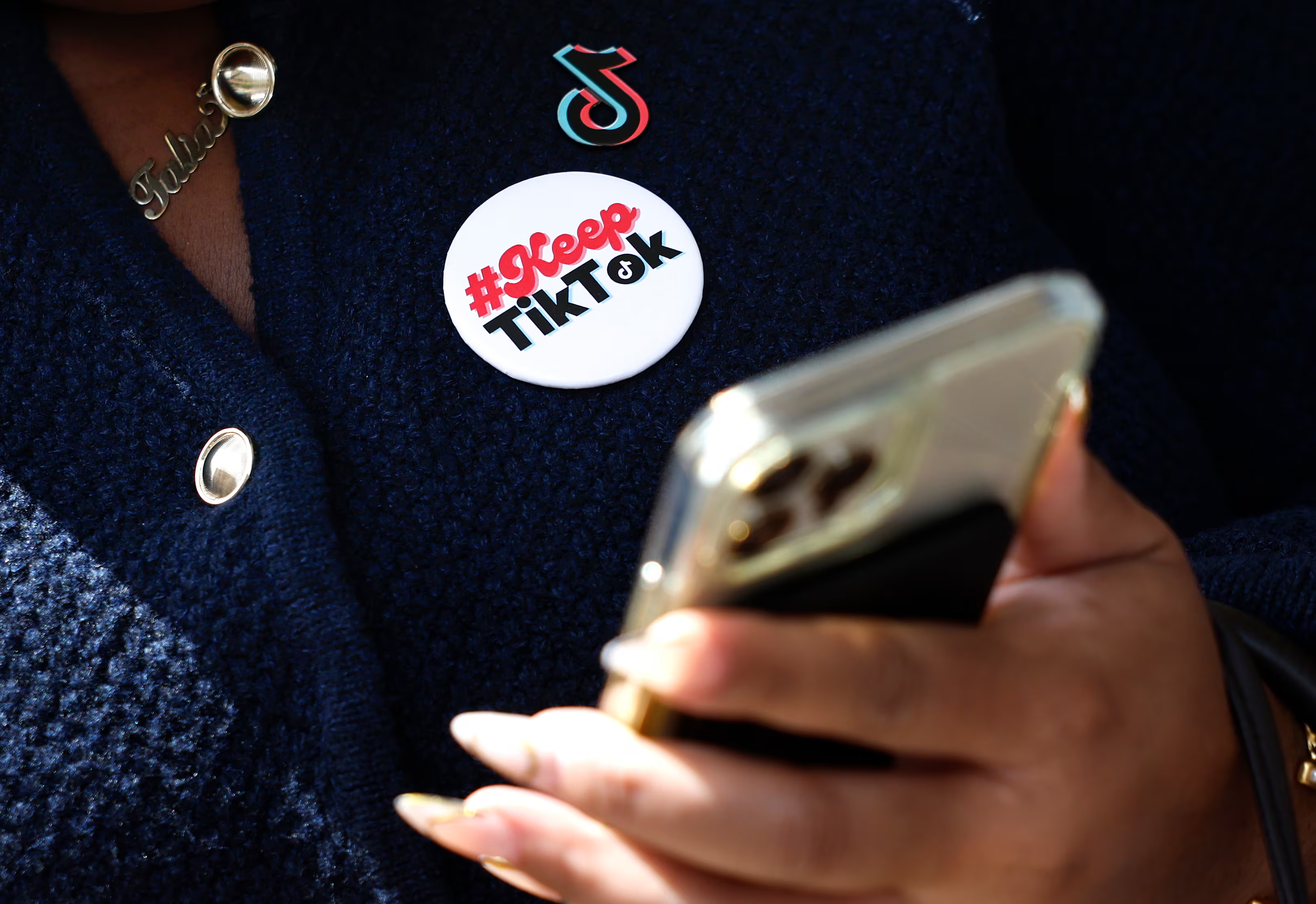The clock is ticking on TikTok. For about 16 hours last weekend, the ubiquitous Chinese-owned and Communist Party–adjacent social-video platform went dark. Then Donald Trump announced on his own social media platform that he would roll back the ban and promised not to punish anyone who kept the app alive. That was a clear message to Oracle chair (and Trump pal) Larry Ellison, whose servers have hosted TikTok in the U.S. since 2022. (Which itself was an effort by TikTok owner ByteDance to assuage U.S. security concerns.) TikTok came back online.
On Monday afternoon, newly inaugurated President Trump signed an executive order pushing back by 75 days the deadline for TikTok to sell itself to a U.S. company or go dark. Trump says he’d be happy if TikTok sold a 50% interest to a U.S. partner and, his cryptic message suggested, 50% to the U.S. government itself. It wasn’t clear if Trump was suggesting that the feds nationalize TikTok, but for certain, Trump was thinking about the Benjamins: “Without U.S. approval, there is no Tik Tok. With our approval, it is worth hundreds of billions of dollars—maybe trillions,” he wrote.
Trump, who had initially ordered the ban in his first term as payback for Covid and later lobbied for it as a national security risk, reversed himself last fall after meeting with billionaire Jeff Yass, managing director of Susquehanna International Group—which donated $92.6 million to Republican candidates and causes in the 2024 election cycle, according to federal data—and himself an investor in ByteDance.
That’s left many people, including the Wall Street Journal’s editorial page, fuming. “TikTok must sever all ties with ByteDance and China. Mr. Trump can’t suspend laws like an English King before the 1689 Bill of Rights,” the paper insisted.
While Trump’s assurances were not enough for Apple and Google, which have removed the TikTok app from their app stores, the overall damage to TikTok so far seems minimal. Some TikTokers opened accounts on a rival Chinese short-video platform called Xiaohongshu, also called RedNote, but most have returned to TikTok. RedNote has been around for a decade, is based in Shanghai, and is owned by Chinese billionaires Charlwin Mao and Miranda Qu. But like TikTok, if asked, it has to turn over all its data to the Chinese government.
Meanwhile, ByteDance is moving ahead with plans to become one of the top AI players in Asia. It’s announced plans to spend $12 billion on AI infrastructure this year, including $5.5 billion to buy AI chips. Sixty percent of the money will go to buying less powerful chips from Chinese makers Huawei and Cambricon, and 40% will go to buying chips from Nvidia. U.S. export restrictions mean even the Nvidia chips will be watered-down versions of what’s available to U.S. allies. But until recently, as the Financial Times reports, Chinese companies have been able to secure access to high-end Nvidia AI chips through rental agreements with third-party data center providers. That loophole was closed last week by the Biden Administration, which issued new rules requiring both the owner and the operator of the chips to undergo a national security review.
However it pans out, ByteDance has said it still plans an initial public offering, and an earlier share buyback from private investors valued the company at $300 billion.(Other estimates range from $30 billion to $100 billion.) That’s big, but still only a tenth the size of Apple.
Watch Big Business This Week on Cheddar—and YouTube!
The Usual Suspects
- How smart is Samsung? The Korean tech giant on Wednesday unveiled its answer to Apple’s GenAI-powered iPhone 16. The S25 replaces last year’s S24, has a new AI operating system built on Google’s Gemini large language model, and uses chips from Qualcomm, not from Samsung’s own troubled chip division. The Korean phone maker holds about 23% of the U.S. market, to Apple’s 53%.
- Big oil gets bigger: As it rushed out the door last Friday, the Biden Administration’s Federal Trade Commission approved a pair of multi-billion-dollar oil company mergers: Exxon’s $60 billion acquisition of Pioneer Natural Resources and Chevron’s $53 billion purchase of Hess. The approval bars the Pioneer and Hess CEOs from serving on the boards of the new companies. The mergers had been held up as the FTC investigated accusations that the firms had colluded to drive up the price of oil and gas for U.S. consumers.
- What’s good for Netflix: Fresh off an astonishing 18.9 million new subscribers in Q4, a 44% rise, Netflix is raising subscription prices to $7.99 a month from $6.99 for its ad-supported tier, and to $24.99 a month from $22.99 for its ad-free premium tier. Netflix shares jumped 15% on the news in aftermarket trading.
- I am car parts: Stellantis, the global car giant that owns Chrysler and FIAT, said it will invest $5 billion in its U.S. operations at plants in Illinois, Ohio, Michigan, and Indiana. United Auto Workers chief Shawn Fain said the investments, announced after Stellantis chief John Elkann met with Trump, had actually been promised a while back but had been reversed by now-former CEO Carlos Tavares, who resigned in December. Stellantis is anxious to please Trump, as 40% of the vehicles it sells in the U.S. are made in Mexico or Canada. Stellantis shares have fallen more than half from a March peak of $29.18.
- Media matters: CNN is laying off about 200 people from its broadcast division, or about 6% of its workers, but CEO Mark Thompson, previously CEO of The New York Times, says he’s going to hire the same number of digital journalists, as the news organization shifts to the web and prepares to launch a streaming channel. CNN’s viewership is down 74% to 578,000 regular prime-time viewers, since it peaked at the end of 2020. MSNBC’s viewership is down 62% in the same period, while Fox News has lost 27% of its viewers. They’re probably all on TikTok.
Elon’s World
After the White House had an unspecified falling out with DOGE partner Vivek Ramaswamy, it announced that Musk will be going it alone in his so-called Department of Government Efficiency, while Vivek prepares to run for governor of Ohio. Meanwhile, Trump announced that DOGE will not be a new department but rather the new name of the U.S. Digital Service, an obscure agency that will now be charged with “modernizing Federal technology and software to maximize governmental efficiency and productivity.” Sounds like the help desk. • On Tuesday, Donald Trump stood with OpenAI CEO Sam Altman, SoftBank CEO Masayoshi Son, and Oracle chair Larry Ellison to announce Stargate, a half-trillion-dollar plan to build artificial intelligence infrastructure in the U.S. That evening Musk tweeted back at Altman, “They don’t actually have the money.” Maybe that’s because Musk is suing Altman for turning OpenAI into a for-profit company, which is competing with Musk’s own xAI—and appears to be leading the field. Or maybe it’s something else.
What do you think of Big Business This Week? Tell us how you really feel in this survey!
The Short Stack
- Power up! The seemingly unquenchable thirst for electricity to power new AI data centers has a South Carolina utility seeking financing to restart two mothballed nuclear reactors. Santee Cooper had already spent about $9 billion on the reactors at the V.C. Summers plant before halting construction in 2017, as competition from gas and renewable energy made it too pricy. But that’s changed as demand explodes for power to run AI data centers.
- Farm fright: U.S. farmers fear that Trump’s tariffs, and the retaliatory tariffs that will likely be placed on U.S. exports, could add massive volatility to agricultural prices, with prices for pork and grain, key exports to China and Mexico, expected to plummet. Last time around, Trump’s tariffs on China cut into U.S. soybean exports and forced the Department of Agriculture to spend millions helping U.S. farmers avoid bankruptcy. Trump’s announcement that tariffs will be phased in gradually already sent some futures contracts higher, but that may be a temporary reprieve if tariffs do in fact hit key markets for agro-business.
Trumplandia
- All the tariffs they can bear: President Donald Trump has threatened sanctions against Russian imports if Russian president Vladimir Putin doesn’t end his war against Ukraine. That’s tough talk, but Russia does virtually no trade with the U.S. Its exports to the U.S. in 2024 were $2.9 billion, down from 2021′s $29.6 billion. What makes up that $2.9 billion? In part, platinum, fertilizers and radioactive chemicals.
- EV envy? As part of his plan to Make America Gasoline-powered Again, Trump signed an executive order rolling back incentives for electric cars and clean energy. Gone are tax credits of $7,500 for new cars and $4,000 for buying a used EV, along with a call by the Biden Adminiistration for half of all new cars sold in the U.S. in 2030 to be electric, plug-in hybrids, or powered by hydrogen. Trump also ordered federal agencies to stop installing high-speed chargers along federal highways. Trump claims the order will revive U.S car making, but with half the cars in China already EVs, the cuts will just put Detroit even further behind the curve. And battery plants and other EV projects that are already in progress risk being abandoned, wasting billions of dollars of investment. But at least one Trump constituency was happy: The American Petroleum institute said in a statement, “This is a new day for American energy.” API’s political action committees, members and staff donated about $6.6 million to Republican causes in the 2024 elections.
- What’s up with $Trump? Last weekend, just before his inauguration, Donald Trump gathered the elite of the crypto world in a Washington ballroom. While they were locked in the opulent Mellon Auditorium, in evening gowns or tuxedos, Trump launched his own meme coin, which soared in value, trading at an astounding volume and hitting a market cap of $14.9 billion overnight. Unsurprisingly, Trump and related organizations and people own 80% of the coin. The next day, a Melania meme coin launched, hitting a market cap of about $3 billion. By Thursday the Trump meme market cap had halved, and the Melania had fallen from an inauguration day high of $13.38 per coin to $2.80 on Thursday. According to CoinMarket Cap, most of the trading happened on obscure Asia-registered platforms including BiKing, Gate.io, and Megabit. Meanwhile, the crypto industry is sulking. “The immediate effect has been draining liquidity and attention away from legitimate projects working on real use cases that the industry desperately needs to prove to the world in 2025,” Serge-Raymond Nzabandora, corporate development and finance manager at Yield Guild Games, a blockchain company, told The Financial Times. But Trump doesn’t seem to mind. The Trump coin, like most meme coins, isn’t meant to be a means of exchange. As its website notes, “The Trump Memes are intended to function as an expression of support for, and engagement with, the ideals and beliefs embodied by the symbol ‘$TRUMP.’”
Get Big Business This Week in your inbox every week—and read it before everybody else! Sign up today.
It’s the Economy, Stupid!
A spiraling national debt, at $36 trillion, and a vast budget deficit could raise inflation and crimp Trump’s plans for massive tax cuts. Already, the GOP is looking at cuts to Medicare, but that’s a third rail and could cost the party the midterm elections. Last year, the government had to borrow $1.9 trillion, or 6.6% of GDP, to bridge the gap between spending and revenue. Most countries try to keep the deficit below 3% of GDP unless they are at war or in the throes of a recession. Over the last 50 years, the U.S. deficit has averaged about 3.8% of GDP. The debt cap has been raised temporarily, but unless that’s made permanent this year, the U.S. could default on some obligations. That would put the brakes on growth as investors would be wary of investing in U.S. debt, and that would contribute to inflation.
Adding to the concern are the impending tariffs. Trump is threatening 25% levies on Mexican and Canadian goods, including Canadian oil. Cutting that cheap oil will push up prices at the pump for consumers, and cutting imports from Mexico and expelling possibly millions of lower-wage workers will also add to inflation. Already Trump has said he’s going to put a 10% tariff on imports from China, which will likely raise the price of everything from smartphones to underwear, and hit lower-income consumers—a large portion of Trump’s voting block—the hardest.
“Trump’s 25% tariffs on Canada will wreck Michigan economy,” ran a headline in The Detroit Free Press, noting that a decline in cross-border trade will wreak havoc on everything from trucking and carmaking to the price of eggs and gasoline.
“This ain’t a game,” Representative David Schweikert, an Arizona Republican and a member of the House Ways and Means Committee, told The New York Times. “This needs to temper both how we approach policy and how we communicate that policy.” He warned that investors on Wall Street were starting to think twice about lending to the United States, a potential loss of confidence in Washington’s tax and spending plans that could ripple across the economy.
Peter S. Green is a veteran reporter and editor who has spent more than two decades covering business and finance from Eastern Europe to New York City, and has worked for Bloomberg News, The New York Post, The New York Times and The Messenger. He lives in New York City and is always looking for the next big story.









